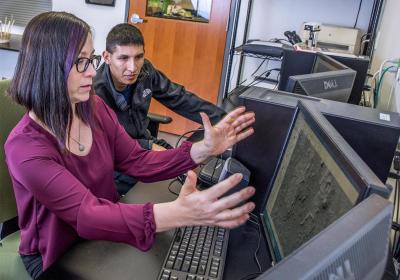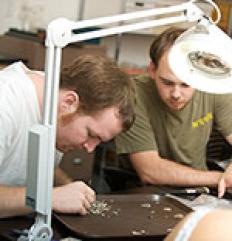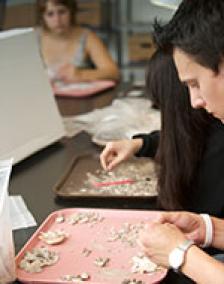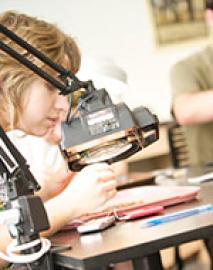Geospatial Archaeology Research Lab

The Geospatial Archaeology Research Laboratory is a research facility dedicated to the scholarly pursuit of knowledge about past cultures within California, nearby, and international areas. As part of the Anthropology Program of Cal Poly Humboldt, the laboratory supports the archaeological research and instructional activities of the faculty. The laboratory provides unique learning and directed-research opportunities for Humboldt students, as well as educational outreach programs within the local community.
Faculty teach courses that integrate lab resources and activities. Classes directly tied to the lab, such as ANTH 358 and 482, are designed to provide students with independent supervised training in the basic archaeological laboratory methods associated with data description, identification, classification, interpretation, presentation, and curation. This course provides hands-on experience with a range of both prehistoric and historical artifacts, assemblages, research questions, analyses, and presentation. Field courses in archaeology, Cultural Resources Management (ANTH 357), and Method and Theory in Archaeology (ANTH 350) emanate from the archaeology laboratory. The laboratory also works with the Cultural Resources Facility, which is adjacent to the lab.
The interwoven research, teaching, and service activities of the Geospatial Archaeological Research Laboratory reflect the university’s commitment to academic excellence and cooperation with other interest groups. Its embedded commitment to faculty-directed student research makes Cal Poly Humboldt the ideal academic environment for the Geospatial Archaeology Research Laboratory. While serving the important research and instructional agenda of the university’s faculty and students, it also serves the needs of others with interests in and a critical responsibility for protecting California’s archaeological past. Collections research carried out by students and professional archaeologists, from within and beyond the walls of the university, serves not only their specialized interests but also contributes to the advancement of general knowledge about California’s rich cultural heritage.
Our Goals:
The Geospatial Archaeology Research Laboratory at Humboldt aims to:
- promote research, including public programs, exhibits, lectures and workshops;
- engage students, scholars and the local community in these efforts;
- develop new paths for outreach to the community (including schools, nonprofit organizations and institutions, and the general public);
- involve a wide range of disciplines in our work, including scholars and practitioners of the humanities and social sciences, the natural sciences, the arts, archaeology, heritage studies and preservation, and the management of cultural resources (CRM).
Student Involvement:
If you’re a student at Humboldt, there’s a lot of ways the Geospatial Archaeology Research Laboratory can help you become more engaged in local and global history. The laboratory has ongoing events and interdisciplinary projects for you to get involved in. For example:
- Belize Archaeology Field School
- Archaeology workshops provide hands-on experience with artifacts, and partaking in archaeological experiments.
- Hold lectures and events on the breadth of human history – archaeology, prehistoric and historic issues.
You and the Geospatial Archaeology Research Laboratory:
It’s our mission to promote an appreciation of our collective past, as individuals, as a community, as an ethnicity and as a nation. We believe that our past is important for understanding who we are today and where we’re headed.
To be an involved citizen and a thinking individual, it’s important to explore and understand how people in the present seek to use the past to identify and distinguish themselves.
As an interdisciplinary center, we believe it’s important to spark insight and understanding among academic disciplines that often work alongside each other but not always in concert. Our differences make us stronger when we come together and we gain greater understanding about how everything, from our culture to the environment, influences our development and history.
Get Involved:
There are several ways to be involved in the lab and archaeology at Humboldt:
- Take courses in archaeology, especially ANTH 358
- Enroll in ANTH 482 Anthropology Internship and apply to work in the lab.
- Volunteer to assist with ongoing student and faculty projects.
Some areas of current interest include:
- Historical ecology and human impacts on marine and terrestrial ecosystems
- Artifact analysis of historic towns such as Faulk
- Settlement patterns in the Maya Lowlands
Resources:
- Simulated archaeological site
- GIS workstations
- Total mapping station
- Done-deployed LiDAR
- Ground penetrating radar
- Portable XRF
- Collections facility
- Wet and dry labs
- Materials for experimental studies (lithics, ceramics, textiles)
- Soil testing
- Reference library
- Teaching & outreach collection
- Zooarchaeology reference collection
- Photography stations
- 3D Scanner and printers
- Survey & excavation equipment
Contact Information:
Byron Smith, Byron.Smith@humboldt.edu (Director)
Barb Klessig, Barbara.Klessig@humboldt.edu (Co-Director)
Location:
Behavioral and Social Sciences (BSS) building, Room 134
Anthropology Department
Cal Poly Humboldt
Cal Poly Humboldt
Arcata, CA 95521
Phone: 707.826.4327
